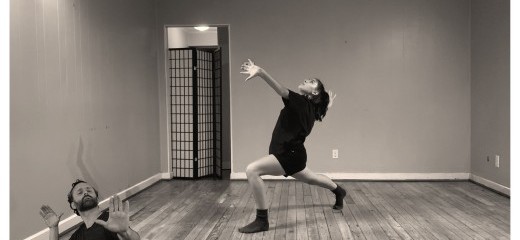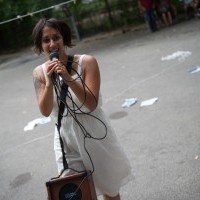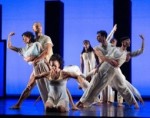
Listening to the dance
by Kristen Shahverdian
“What makes a performance? What’s a performance for?” These two questions were asked vocally, via ASL interpreters and through closed captioning, early in the documentary screendance film Telephone, and they undergird how I watch and listen to the 45-minute film. The questions take on elevated poignancy and importance because Telephone is a fully accessible film that pioneers a new form of audio description for dance; a film created for all, but as our narrator states, “with a visually impaired audience in mind.” How do creators answer these questions? The answers can affect and inform how choreographers and producers make performance accessible. This iteration of Telephone was hosted by Accessibility at Lincoln Center for the Performing Arts and included a 75 minute Q&A with co-directors Heather Shaw and Krishna Washburn.
Washburn, the director of Dark Room Ballet and an audio description educator, explains during the Q&A that audio descriptions (AD) for dance have been inherited through film, where a rich language exists through the script. Oftentimes, dance does not have dialogue, so the neutral voice-over that merely describes neglects the variations in physicality that affect how one emotionally receives the dance. Washburn describes an experience she had listening to the audio descriptions of an iconic dance performance years ago. As she heard audience members around her crying, she knew they were not responding to what she was hearing - a leg kick, a leap, or a jump. She realized that she and other visually impaired audience members miss a huge part of a performance, the part that is at the heart of the question, “What is a performance for.” Telephone challenges the history of AD by embarking on a new form of AD for dance that adds the how and the where to the previous ‘what’ of movement description. Washburn and the audio describers throughout the film are artists, and the words they choose and how they perform them is an art form in itself – not an add-on to the film to create accessibility, but an inherent and essential part of the film. “Breathing, push against floor, looking shocked to be moving, catch, turn with shoulders against wall;” the audio describers’ voices reflect the energetic and thoughtfully timed qualities that allow the dancers to communicate and share an emotional connection with the audience.
Shaw and Washburn conceived of the film, a documentary screen dance, during the early days of the pandemic. Its title comes from the children’s game “telephone” (sometimes called “whisper down the lane.”). Shaw choreographed the initial movement phrase featured in Telephone and shared it with an audio describer, and the description was then passed on to the next dancer, who created their own physical interpretation of the phrase, and so on - until 13 different iterations of the original phrase were created and filmed, along with 13 audio describers, 2 ASL interpreters, and closed captioning throughout. The dancers filmed their sections in living rooms, bedrooms, or studios, and always alone, reflecting the social isolation of the pandemic. However, this film is not about isolation. Telephone is a multi-layered immersive journey that invites everyone in, at any sight level, to experience the fullness of dance performance. Alternating with the dancing sections, there are sections of pure narration (along with captioning and ASL interpreters) where the filmmakers contemplate performance and accessibility for the visually impaired in dance. Depending on the audience member, these sections can be illuminating teaching moments or could be validating and affirming of the challenges of AD for dance.
When the film begins, we see a dark screen that fades into a living room. Shaw walks quickly down a hallway and towards the camera. She leans into the wall, her hand reaches onto it, she turns, her knee lifts up. As Shaw performs, another artist, the audio describer, gives us not just the words for the movements, as I have above, but uses her voice to inflect the pace and effort quality of Shaw’s dance. The audio describer talks faster, mimicking the dancer’s movement, when she says, “walk-walk-walk.” She slows down and drags her voice over the words, “look away,” mirroring the dancer’s physicality.
Washburn asks performers to reflect, “why are we reaching our arm?” Are we reaching toward someone? Is it a memory? How do we want our audience to experience this arm moving in space? If art is necessary, if we all need art, if art is, as she suggests, “a communion,” then are creators not responsible to all of our audience?
I am aware that my experience and what I write here are shaped by my ability to see the dancers, the closed captioning, and the ASL interpreters, as well as hear the narration and soundscore throughout the film. I’m submersed into a vivid landscape of sounds, words, movements, and interpretations that make each dancer’s phrase seem wholly new. The connective tissue of the original phrase becomes a subconscious thread, one where I don’t spend my time ‘finding’ the original phrase. Although each dancer is alone, the piece is not lonely. Instead, by placing accessibility at the forefront, the filmmakers also place humanity and connection at the forefront of the performance experience.
*For further information on AD and Krishna Washburn’s work, please see this interview called Access and Artistry Part 1
Telephone, Heather Shaw and Krishna Washburn, Lincoln Center, Aug. 22
Homepage Image description: Black and white image of Telephone dancer Toby MacNutt as theysit on their heels, hands interlaced over chest/top of stomach. Toby's crutches are laid out in front of them as they look to the side in a plant filled dance studio.
Article Image: Black and white image of Telephone dancer Camille Tokar Pavliska, wearing dark shorts and tee-shirt dancing in an empty room. She is in a deep lunge with her arms spread out, wrists flexed. ASL Performer Ian Sanborn's upper body is overlaid in the lower left part of the image, with arms spread on the diagonal and head slightly back.
By Kristen Shahverdian
September 13, 2024









